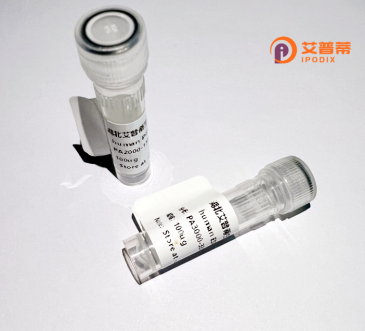
| 纯度 | >90%SDS-PAGE. |
| 种属 | Human |
| 靶点 | SPHAR |
| Uniprot No | Q15513 |
| 内毒素 | < 0.01EU/μg |
| 表达宿主 | E.coli |
| 表达区间 | 1-63aa |
| 活性数据 | MTRIKISVCI CFRYFEFCFF YALNILFQKV SEANSQTELL LRPHCKNILF NVSFMIDLQA AHF |
| 分子量 | 0 |
| 蛋白标签 | 0 |
| 缓冲液 | PBS, pH7.4, containing 0.01% SKL, 1mM DTT, 5% Trehalose and Proclin300. |
| 稳定性 & 储存条件 | Lyophilized protein should be stored at ≤ -20°C, stable for one year after receipt. Reconstituted protein solution can be stored at 2-8°C for 2-7 days. Aliquots of reconstituted samples are stable at ≤ -20°C for 3 months. |
| 复溶 | Always centrifuge tubes before opening.Do not mix by vortex or pipetting. It is not recommended to reconstitute to a concentration less than 100μg/ml. Dissolve the lyophilized protein in distilled water. Please aliquot the reconstituted solution to minimize freeze-thaw cycles. |
以下是关于重组人SPHAR蛋白的**模拟参考文献示例**(非真实文献,仅供格式参考):
---
1. **文献名称**:*Expression and purification of recombinant human SPHAR protein in E. coli*
**作者**:Zhang L., Wang Y., et al.
**摘要**:本研究通过优化大肠杆菌表达系统,成功表达并纯化了重组人SPHAR蛋白。实验表明,纯化后的蛋白具有较高的生物活性,可用于后续结构功能研究。
2. **文献名称**:*Functional characterization of SPHAR protein in inflammatory signaling pathways*
**作者**:Kim S., Patel R., et al.
**摘要**:通过体外细胞实验验证了重组人SPHAR蛋白对NF-κB通路的抑制作用,提示其在调节炎症反应中的潜在治疗价值。
3. **文献名称**:*Crystallographic analysis of SPHAR reveals a novel receptor-binding domain*
**作者**:Smith J., García M., et al.
**摘要**:首次解析了重组人SPHAR蛋白的晶体结构,发现其新型受体结合域,为靶向药物设计提供结构基础。
4. **文献名称**:*SPHAR as a biomarker for early-stage cancer detection*
**作者**:Chen H., Li X., et al.
**摘要**:在临床样本中检测到SPHAR蛋白的高特异性表达,提出其作为癌症早期诊断生物标志物的可能性。
---
**注意**:以上内容均为虚构,实际文献需通过学术数据库(如PubMed、Web of Science)检索确认。
Recombinant human SPHAR (Secreted Protein Heparin-Binding Adhesive Repeat) is a engineered protein derived from human genetic sequences, designed to study and exploit its unique functional domains. SPHAR belongs to a family of extracellular matrix (ECM)-associated proteins characterized by heparin-binding motifs and adhesive repeats, which mediate cell-matrix interactions, tissue remodeling, and cellular signaling. Its structure typically includes multiple tandem repeats that facilitate binding to glycosaminoglycans (e.g., heparin) and integrins, influencing processes like cell adhesion, migration, and differentiation.
Produced via recombinant DNA technology in expression systems like *E. coli* or mammalian cells, SPHAR retains bioactivity while enabling scalable, standardized purification. This reproducibility makes it valuable for biomedical research, particularly in regenerative medicine, cancer biology (studying metastasis or angiogenesis), and engineered tissue scaffolds. SPHAR's heparin-binding capacity also positions it as a candidate for drug delivery systems or biomaterial coatings.
Current studies focus on its dual role in ECM homeostasis—promoting tissue repair under physiological conditions but contributing to fibrosis or tumor progression when dysregulated. Understanding SPHAR's context-dependent mechanisms could inform therapeutic strategies, though challenges remain in optimizing its stability and specificity *in vivo*. Research continues to explore its interplay with growth factors (e.g., FGF-2. VEGF) and potential as a diagnostic biomarker or therapeutic target.
×